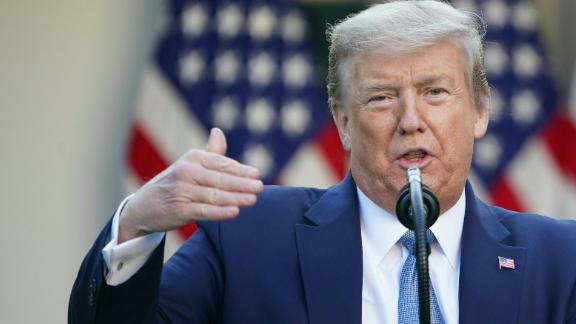Fact check: Trump wrongly declares some states don’t have ‘any problem’ with coronavirus

President Donald Trump inaccurately declared at Thursday’s White House coronavirus briefing that some states do not have “any problem” with the virus’s outbreak, minimizing the situation even in the least-affected states.
Trump also repeated his incorrect suggestion that he has the power to decide when governors lift their pandemic-related restrictions. And he argued that “people should have told us” about the virus, omitting the fact that he continued to downplay the virus for weeks after public warnings.
We fact checked these items below.
States without any problems
As part of the administration’s three-phase recommendation for re-opening the country, Trump said some states could be ready to enter phase one of the reopening process as soon as Friday because, when it comes to coronavirus, “you have states without any problem.” He added that some states are “at a point where there is almost nothing” in terms of coronavirus cases, and that “you have states with few cases and those few cases have healed.”
Facts First: It’s not true that some states currently don’t have “any problem” related to coronavirus. At the time the President spoke, all 50 states each had more than 200 confirmed cases, and 41 states have more than 1,000 confirmed cases. There is no definitive state-by-state data on how many infected people have recovered.
Wyoming, which has the fewest cases of any state, has reported 288 cases. While Trump was hesitant to name which specific states could be the first to reopen, none of them have close to zero cases, according to the latest data from Johns Hopkins University. Further, testing issues have raised concerns that cases or deaths are being undercounted, so it’s difficult to know the accuracy of the existing data.
Trump has made similar false claims in past briefings. In early April, he said that certain states, specifically those without stay-at-home orders, were “not in jeopardy” or at risk from the coronavirus. The number of coronavirus cases in all those states, except Wyoming, have since more than doubled, though two of them — Wyoming and North Dakota — remain among the five states with the least amount of cases.
The President’s powers
Trump said of state governors: “If they need to remain closed, we will allow them to do that. And if they believe it is time to reopen, we will provide them the freedom and guidance to accomplish that task, and very, very quickly, depending on what they want to do.”
Facts First: State governors already have the power to decide that they need to maintain their coronavirus restrictions, legal scholars say. It is not up to the President to “allow them to do that.”
Trump’s comment was similar to his Tuesday declaration that he was “authorizing” the governors to lift their restrictions as they pleased. Experts say that the governors have a long-established constitutional authority over public health matters and do not need the President’s permission to implement or maintain pandemic-related closures.
On Thursday, Trump did not repeat his Monday claim that he has “total” authority over the state restrictions or his Wednesday claim that “we have the right to do whatever we want.” But he was still implicitly suggesting that he has power he does not have.
You can read a longer fact check on this subject here.
People should’ve told us
The President again expressed frustration that coronavirus warnings “should have been told to us a lot sooner.”
“I was angry, because this should have been told to us. It should have been told to us early. It should have been told to us a lot sooner,” Trump said. “People knew it was happening, and people didn’t want to talk about it. I don’t know why. But we’re going to get to the bottom of it.”
When pressed about whether he meant China, Trump deflected: “I’m not saying anything. I’m saying people should have told us about this. They should have told the rest of the world, too.”
Facts First: Trump did not go into detail about who he is referring to here, but Trump’s comments are misleading because they ignore repeated warnings Trump received from sources, including the World Health Organization, the US intelligence community and even his own advisers. And while the WHO has faced its own share of criticism for its coronavirus response (and there are legitimate questions about China’s handling of the pandemic as well), it is worth noting that Trump continued to downplay the pandemic even after such warnings were clear.
For context: One day after the World Health Organization declared the coronavirus outbreak a “public health emergency of international concern,” the Trump administration blocked foreigners who visited China from entering the country.
But Trump continued to downplay the seriousness of the disease, likening it to the flu nearly a month later. At the coronavirus briefing on February 26, Trump made all of the following comments: “This is a flu. This is like a flu”; “Now, you treat this like a flu”; “It’s a little like the regular flu that we have flu shots for. And we’ll essentially have a flu shot for this in a fairly quick manner.”
A New York Times investigation into the Trump administration’s coronavirus response also found that Trump repeatedly ignored warnings from top health advisers about the spread of the lethal disease.
You can read more about Trump’s claims that it was unknown how contagious the coronavirus was here, and more on Trump’s false claim that the pandemic crisis was “unforeseen” here.
